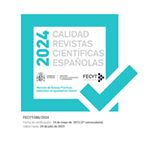Letters from the convent: female epistolary models in Counter-Reformation Spain
Abstract
Convents in the early modern period were, as is widely known, a privileged space for women’s writing especially with regard to epistolary activity. Taking into consideration the main features of this written production and the nuns’ writing culture, this essay compares the letters of Teresa de Jesús (Teresa of Ávila) to the correspondence of Sister María de Jesús de Ágreda with King Philip IV. This analysis reveals deeply seated epistolary patterns. On the one hand, the Ávila letters show the daily role played by written communication in the Carmelite reform and the importance of writing for the relationships between nuns within the order. On the other hand, Ágreda’s correspondence with the king is much closer to the profile of the “divine mother”, a profile emphasizing the moral authority played by the nuns, whose spiritual advice was often demanded by kings and other members of the elite.Downloads
Article download
License
In order to support the global exchange of knowledge, the journal Cuadernos de Historia Moderna is allowing unrestricted access to its content as from its publication in this electronic edition, and as such it is an open-access journal. The originals published in this journal are the property of the Complutense University of Madrid and any reproduction thereof in full or in part must cite the source. All content is distributed under a Creative Commons Attribution 4.0 use and distribution licence (CC BY 4.0). This circumstance must be expressly stated in these terms where necessary. You can view the summary and the complete legal text of the licence.












